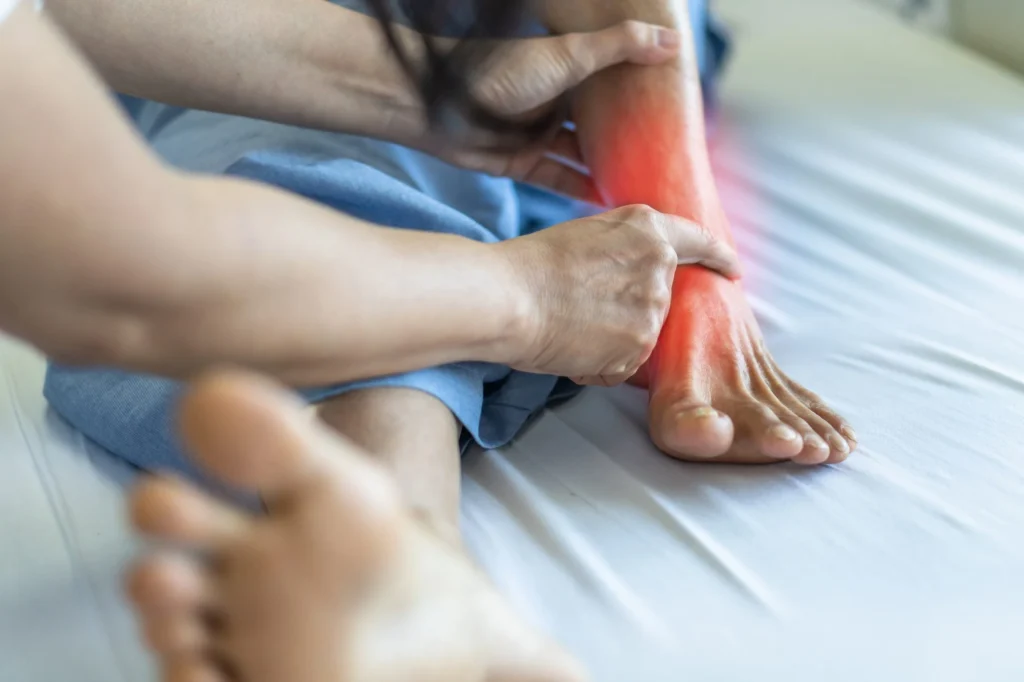Pain on the top of the foot can result from overuse, injury, or medical conditions affecting the tendons, muscles, joints, and bones. This discomfort may lead to difficulty walking or standing, accompanied by swelling or tingling. Identifying the cause helps determine whether it’s an injury or a condition, such as arthritis or tendonitis.
Treatment may involve rest and medication, as foot health is crucial for support and mobility. In this blog post, we’ll discuss additional causes of pain, home relief strategies, and when to see a healthcare provider.
What causes pain on top of the foot?
Experiencing pain on the top of your foot can result from various health issues, most commonly due to overuse. This often occurs when you exert your feet too much, as during activities like running.
Here are some common reasons why you might experience pain on the top of your foot:
- Extensor tendonitis occurs when the tendons on the top of your foot become inflamed due to overuse or wearing tight shoes, resulting in pain.
- Stress fractures: These small cracks in the bones of your foot, particularly in the metatarsal bones at the top of your feet, can lead to pain and swelling.
- Sinus tarsi syndrome: Inflammation of the channel between your heel and ankle bone can cause pain on the top of your foot and outside the ankle.
Foot pain can stem from several causes, including gout (leading to sudden pain in the big toe), bone spurs (painful growths near toe joints), peripheral neuropathy (tingling and numbness in the feet and legs), and common peroneal nerve dysfunction (tingling and weakness in the foot or lower leg).
How is the pain diagnosed?
If you experience foot pain lasting more than a week that doesn’t improve with home treatment, it’s essential to consult a doctor. This is especially true if the pain is severe, prevents you from walking, or involves burning, numbness, or tingling. You may be referred to a podiatrist for specialized care.
During your appointment, the doctor will ask about your symptoms, past injuries, and your level of physical activity. They will examine your foot for pain and assess its range of motion. If extensor tendonitis is suspected, they may check for pain while you flex your foot and pull your toes up. An X-ray might be ordered for possible broken bones or bone spurs.
Additional tests, such as blood tests for conditions like gout or an MRI for nerve damage, may be recommended. It’s essential to follow your doctor’s advice and undergo the necessary tests to determine the cause of your foot pain.
How is the pain treated?
Taking care of your feet is essential because they support your entire body. If you have a mild foot injury, it’s best to seek treatment promptly to prevent any further complications.
Treatment for foot injuries can include:
- Physical therapy can help alleviate various conditions, including nerve damage and tendonitis.
- Using a cast or walking boot: This may be necessary for more severe injuries, such as broken bones.
- Anti-inflammatory drugs can help reduce swelling and pain, particularly in conditions such as gout.
- Home treatments: Resting your foot, applying ice, and wearing supportive shoes can help alleviate pain and promote healing.
Remember to take care of your feet and seek medical attention if you suspect any injury to ensure a speedy recovery.
What’s the outlook for top-of-foot pain?
Most causes of pain on the top of the foot can be easily treated, but it’s essential to address them early to prevent further injury. If you’re experiencing pain on the top of your foot, try to avoid putting pressure on it for at least five days and use ice on the area for short periods. If the pain persists after trying these home remedies for five days, it may be a good idea to see a doctor for further evaluation and treatment.
Conclusion
In conclusion, pain on the top of the foot can be caused by various factors, including injuries, overuse, or certain medical conditions. It is essential to consult a healthcare professional for an accurate diagnosis and an appropriate treatment plan. Treatment options may include rest, ice, elevation, and, in some cases, physical therapy or the use of orthotics. By addressing the underlying cause of the pain and following the recommended treatment plan, individuals can effectively manage and alleviate discomfort in the top of their foot.

